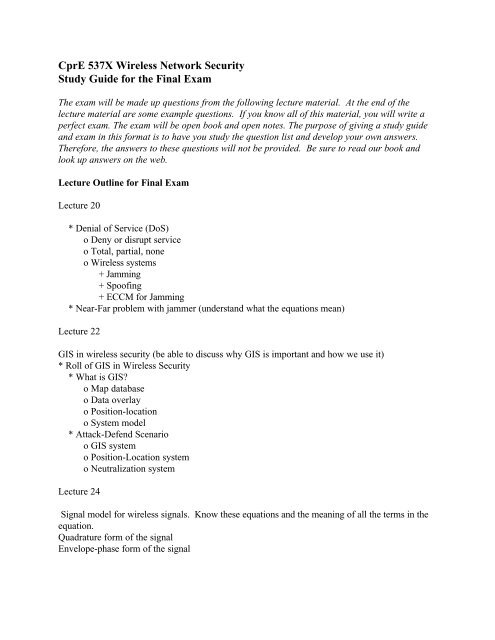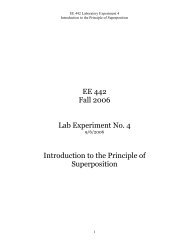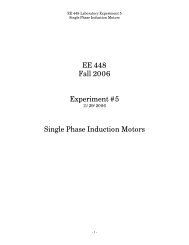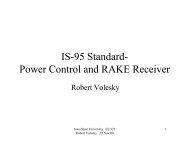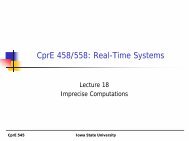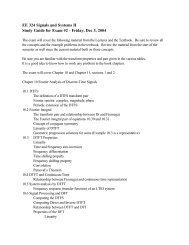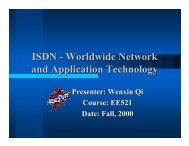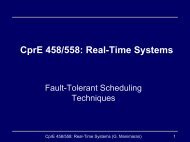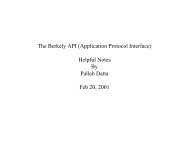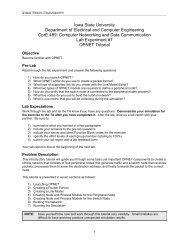CprE 537X Wireless Network Security Study Guide for the Final Exam
CprE 537X Wireless Network Security Study Guide for the Final Exam
CprE 537X Wireless Network Security Study Guide for the Final Exam
Create successful ePaper yourself
Turn your PDF publications into a flip-book with our unique Google optimized e-Paper software.
<strong>CprE</strong> <strong>537X</strong> <strong>Wireless</strong> <strong>Network</strong> <strong>Security</strong><br />
<strong>Study</strong> <strong>Guide</strong> <strong>for</strong> <strong>the</strong> <strong>Final</strong> <strong>Exam</strong><br />
The exam will be made up questions from <strong>the</strong> following lecture material. At <strong>the</strong> end of <strong>the</strong><br />
lecture material are some example questions. If you know all of this material, you will write a<br />
perfect exam. The exam will be open book and open notes. The purpose of giving a study guide<br />
and exam in this <strong>for</strong>mat is to have you study <strong>the</strong> question list and develop your own answers.<br />
There<strong>for</strong>e, <strong>the</strong> answers to <strong>the</strong>se questions will not be provided. Be sure to read our book and<br />
look up answers on <strong>the</strong> web.<br />
Lecture Outline <strong>for</strong> <strong>Final</strong> <strong>Exam</strong><br />
Lecture 20<br />
* Denial of Service (DoS)<br />
o Deny or disrupt service<br />
o Total, partial, none<br />
o <strong>Wireless</strong> systems<br />
+ Jamming<br />
+ Spoofing<br />
+ ECCM <strong>for</strong> Jamming<br />
* Near-Far problem with jammer (understand what <strong>the</strong> equations mean)<br />
Lecture 22<br />
GIS in wireless security (be able to discuss why GIS is important and how we use it)<br />
* Roll of GIS in <strong>Wireless</strong> <strong>Security</strong><br />
* What is GIS?<br />
o Map database<br />
o Data overlay<br />
o Position-location<br />
o System model<br />
* Attack-Defend Scenario<br />
o GIS system<br />
o Position-Location system<br />
o Neutralization system<br />
Lecture 24<br />
Signal model <strong>for</strong> wireless signals. Know <strong>the</strong>se equations and <strong>the</strong> meaning of all <strong>the</strong> terms in <strong>the</strong><br />
equation.<br />
Quadrature <strong>for</strong>m of <strong>the</strong> signal<br />
Envelope-phase <strong>for</strong>m of <strong>the</strong> signal
Lecture 25<br />
Organizing bits and mapping <strong>the</strong>m to a(t) and b( t) <strong>for</strong> creating a wireless signal. <strong>Study</strong> how <strong>the</strong><br />
wave<strong>for</strong>m symbols relate to <strong>the</strong> bits<br />
Lecture 26<br />
a(t) and b(t) wave<strong>for</strong>ms (electrical pulses ), be able to draw <strong>the</strong>m and explain how <strong>the</strong>y relate to<br />
<strong>the</strong> bits.<br />
SHANNON’S CHANNEL CAPACITY THEOREM<br />
study this and be able to work a problem. You will need to know logarithms.<br />
Lecture 27<br />
How is channel capacity optimized?<br />
Explain <strong>the</strong> concept of a signal constellation and how it relates to bits and symbols.<br />
Lecture 28-29<br />
Modeling noise and interference with quadrature signals. Be able to explain <strong>the</strong> equations and<br />
what <strong>the</strong>y mean. Be able to draw a vector diagram of <strong>the</strong> I-Q signals constellation.<br />
Lectures 30-33<br />
Write a paragraph describing <strong>the</strong> HONEYNET Project<br />
Write a paragraph describing <strong>the</strong> DILON Project<br />
Write a paragraph describing WAR DRIVING<br />
Write a paragraph describing ANTENNAS<br />
Lecture 34-38<br />
Be able to describe <strong>the</strong> multiple access methods and be able to draw a diagram and/or give an<br />
equation.<br />
FDMA, TDMA, CDMA, SDMA<br />
Be able to explain and use <strong>the</strong> equations <strong>for</strong> CDMA<br />
* DSSS <strong>for</strong> Code Division Multiple Access<br />
o Regular receiver plus correlator<br />
o Equations modeling correlation<br />
o Multi-User interference from many stations<br />
o Multi-User noise model<br />
* CDMA math model<br />
o multi-user interference model<br />
o Jamming model
o jamming margin (jamming gain)<br />
Lecture 39<br />
Mobile Ad Hoc <strong>Network</strong>ing (be able to describe <strong>the</strong> issues we discussed)<br />
Lecture 40<br />
Matrix model <strong>for</strong> mobile ad hoc networking<br />
Some <strong>Exam</strong>ple Questions and Topics <strong>for</strong> <strong>Final</strong> <strong>Exam</strong><br />
* These example questions are taken from <strong>the</strong> lectures. I may ask <strong>the</strong> same question in a slightly<br />
different way. Some topic areas <strong>for</strong> questions below may overlap. There may not be an example<br />
question <strong>for</strong> every topic that may be on <strong>the</strong> exam.<br />
Describe denial-of-service (DoS) <strong>for</strong> a wireless system.<br />
Describe <strong>the</strong> near-far problem in wireless using <strong>the</strong> terms defined in lecture.<br />
What is <strong>the</strong> role of GIS in wireless network security. Write a complete description of <strong>the</strong> ways<br />
that GIS can be used.<br />
What is GIS?<br />
Give an example of <strong>the</strong> Time-Frequency model <strong>for</strong> FHSS. Use a diagram in your description.<br />
Describe why position-location is such a big issue in wireless.<br />
Write a definition <strong>for</strong> "multiple-access" as it applies to a wireless system.<br />
Completely describe <strong>the</strong> time domain representation of a wireless signal.<br />
What is a typical signal constellation <strong>for</strong> a wireless signal? Draw a diagram to illustrate your<br />
definition.<br />
What is <strong>the</strong> I/Q phasor domain representation of a signal in <strong>the</strong> time domain.<br />
Define Shannon's channel capacity <strong>the</strong>orem.<br />
Calculate <strong>the</strong> capacity of a channel given <strong>the</strong> channel parameters.<br />
Write a description <strong>for</strong> an antenna and give an example of its radiation pattern. Include a
description of <strong>the</strong> beam power pattern and antenna gain.<br />
Write a complete description of a honeynet.<br />
Write a complete description of DILON.<br />
Write a complete description of war driving.<br />
Write <strong>the</strong> model <strong>for</strong> a DSSS signal out of a radio transmitter. Define each variable or parameter<br />
in <strong>the</strong> equation.<br />
Write a complete description of a correlation receiver, including <strong>the</strong> basic equations that describe<br />
how it works.<br />
Write a complete description of multiuser interference <strong>for</strong> a DSSS system.<br />
How is <strong>the</strong> jammer affected by <strong>the</strong> correlation process in a DSSS system? Use equations and/or<br />
plots in your description.<br />
Draw <strong>the</strong> spectrum of a DSSS signal with its equivalent narrowband signal and describe jamming<br />
margin <strong>for</strong> <strong>the</strong> system.<br />
What is a mobile ad hoc network?<br />
What are <strong>the</strong> individual functions of a node in a mobile ad hoc network?<br />
Describe <strong>the</strong> connection matrix <strong>for</strong> a mobile ad hoc network.


